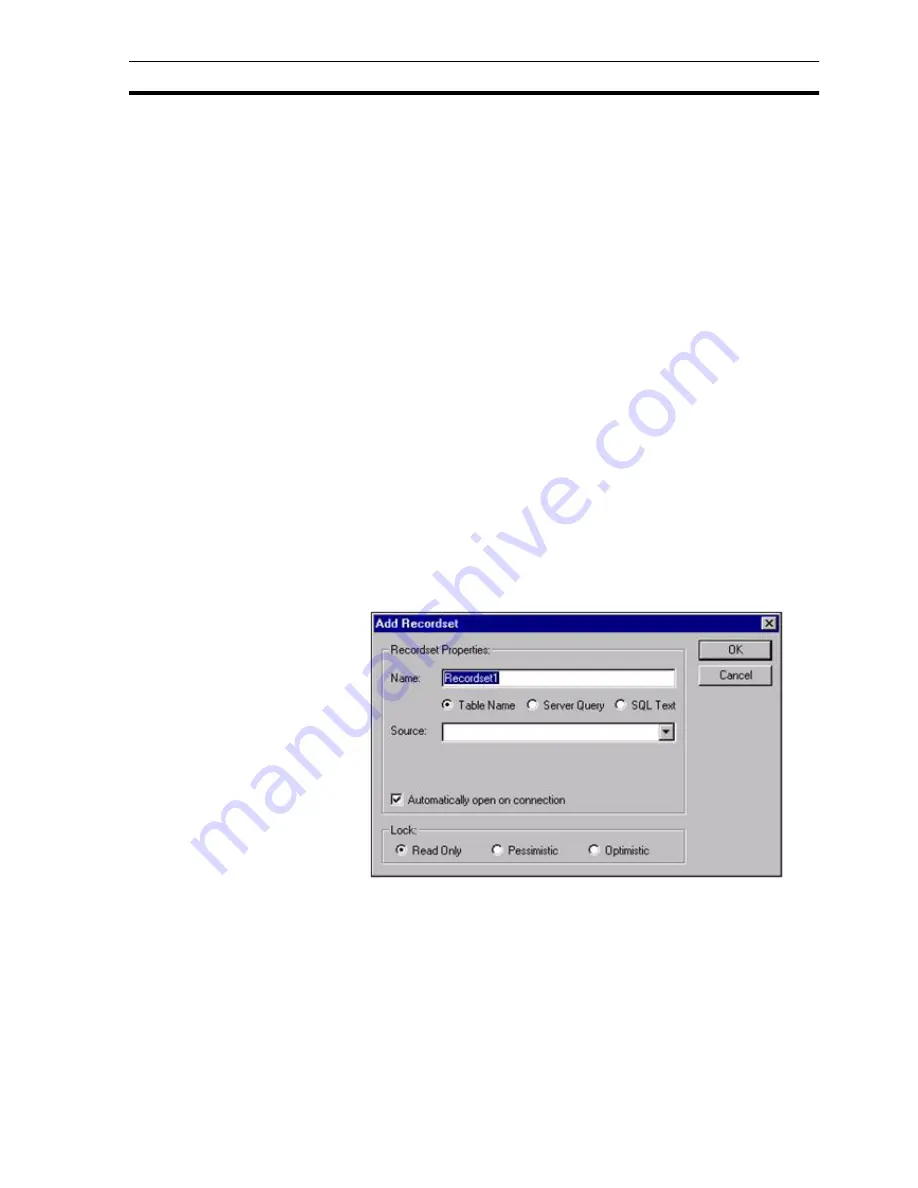
Configuring Recordsets
SECTION 12 Databases
187
12-2-7 Creating a Read/Write connection to CSV/Text file
Connections to CSV or Text files using the Provider installed with ADO version
2.0, like Excel files, are also read only hence Records can not be added or
amended. However, CSV and Text files can be updated by converting the data
into an Excel spreadsheet and accessing the file via the ODBC DSN driver.
This is achieved by carrying out the steps as above using the CSV/Text file
instead. Note the Excel provider is still used, and a named range in Excel must
still be created.
12-3
Configuring Recordsets
The Recordset is the heart of the Database facility, it contains all of the
columns and rows returned from a specific action. The Recordset is used to
navigate a collection of records, and update, add, delete or modify records.
When a Connection has been added to the Workspace, the right menu option
'Add Recordset…' will be enabled. Selecting this option will invoke the
following dialog box:
12-3-1 Name
A unique Recordset name will be automatically provided. This can be modified
to provide a more meaningful name if required.
12-3-2 Recordset Type
The Recordset can be 1 of 3 types:
Note:
When updating files the column headings cannot contain numbers or spaces,
for example "Column1" or "Invoice Total" is invalid. Also some words are
reserved and can not be used, for example a column heading of "Number" will
cause an error. These restrictions do not apply when only reading these files.
Note:
Make sure that all the cells in a column are of the same data type. The Excel
ODBC driver cannot correctly interpret which data type the column should be if
a column is not of the same type, or you have types mixed between "text" and
"general".
Note:
This type of querying and updating information in an Excel Spreadsheet does
not support multi-user concurrent access.
Table Name
The Recordset is the name of an actual table in the
Database.
Summary of Contents for CX-Supervisor
Page 1: ...CX Supervisor Software Cat No W10E EN 01 User Manual Software Release 3 1...
Page 3: ...Copyright Notice 2...
Page 16: ...15...
Page 17: ...16...
Page 27: ...Tip of the Day SECTION 1 Graphics Editor 26...
Page 35: ...CX Supervisor Preferences SECTION 2 Pages 34...
Page 79: ...Responding to Events SECTION 5 ActiveX Objects 78...
Page 115: ...Printing the Graphics Library SECTION 7 Graphics Library 114...
Page 181: ...Data Logging SECTION 11 Data Logging 180...
Page 201: ...Examples SECTION 12 Databases 200...
Page 243: ...Performance Monitor SECTION 16 Application Analysis Performance Monitor 242...
Page 253: ...Using with Omron s CX Server OPC SECTION 17 Using CX Supervisor as an OPC Cli 252...
Page 259: ...Creating a CX Supervisor Client application SECTION 18 Connecting to a remote CX 258...
Page 263: ...Adding a Point Linked to a Parameter SECTION 19 Connecting to Omron Industrial 262...
Page 271: ...Data Logging SECTION 20 Best Practices 270...
Page 275: ...Configuring a Server PC running Windows NT or 2000 Appendix A Configuring a PC 274...
Page 277: ...Appendix B Frequently Asked Questions 276...
Page 296: ...Appendix B Frequently Asked Questions 295...
Page 297: ...Appendix B Frequently Asked Questions 296...
Page 298: ...Appendix B Frequently Asked Questions 297...
Page 299: ...Appendix B Frequently Asked Questions 298...
Page 333: ...Revision history 332...






























